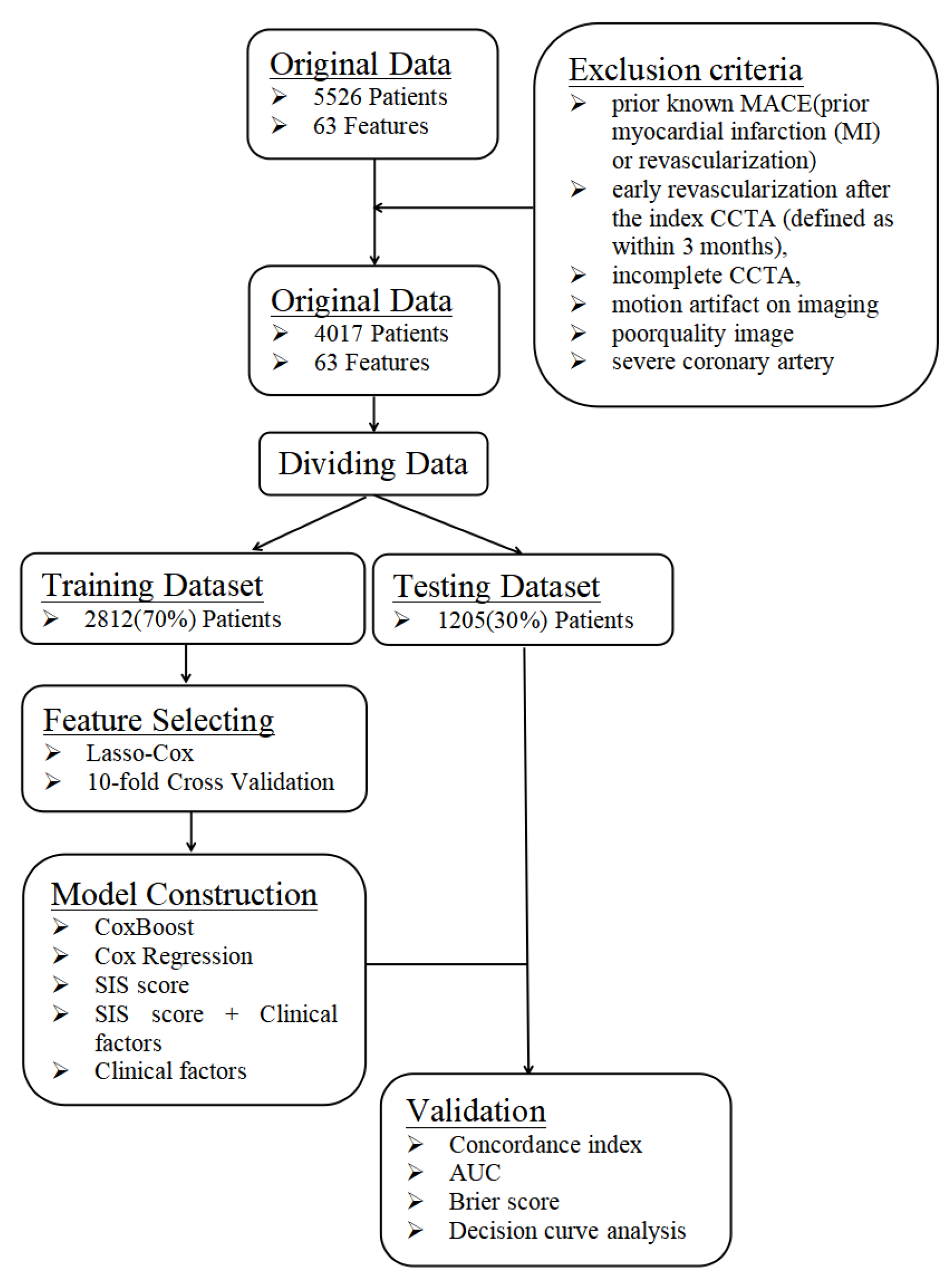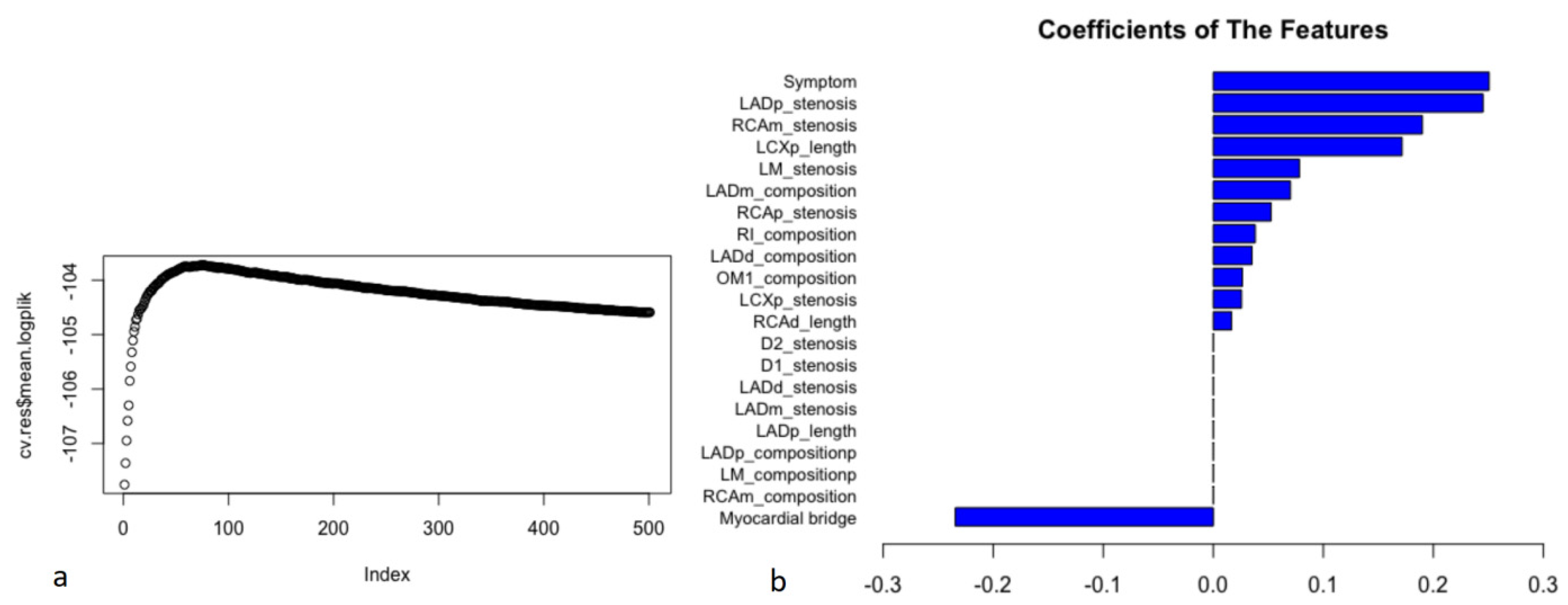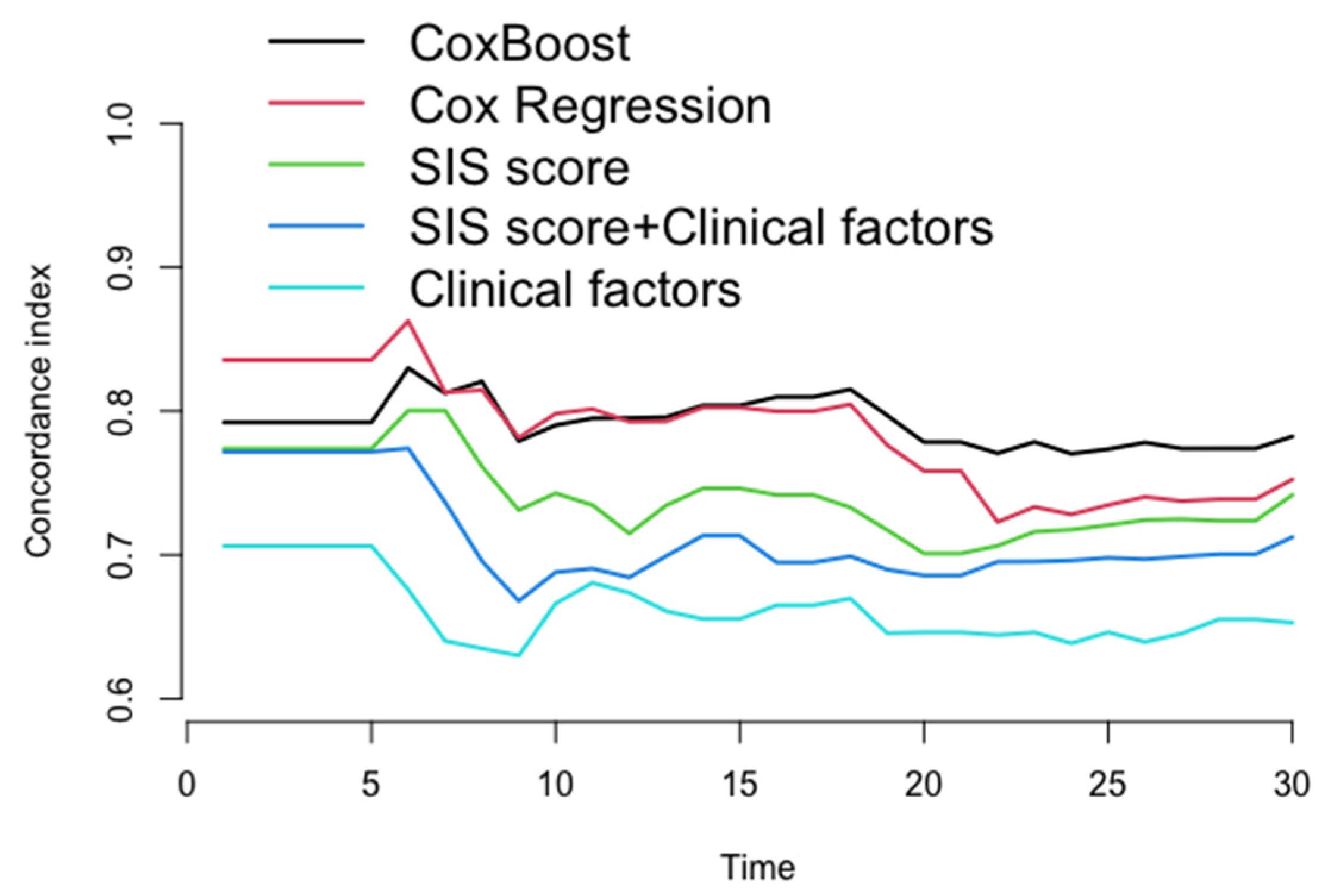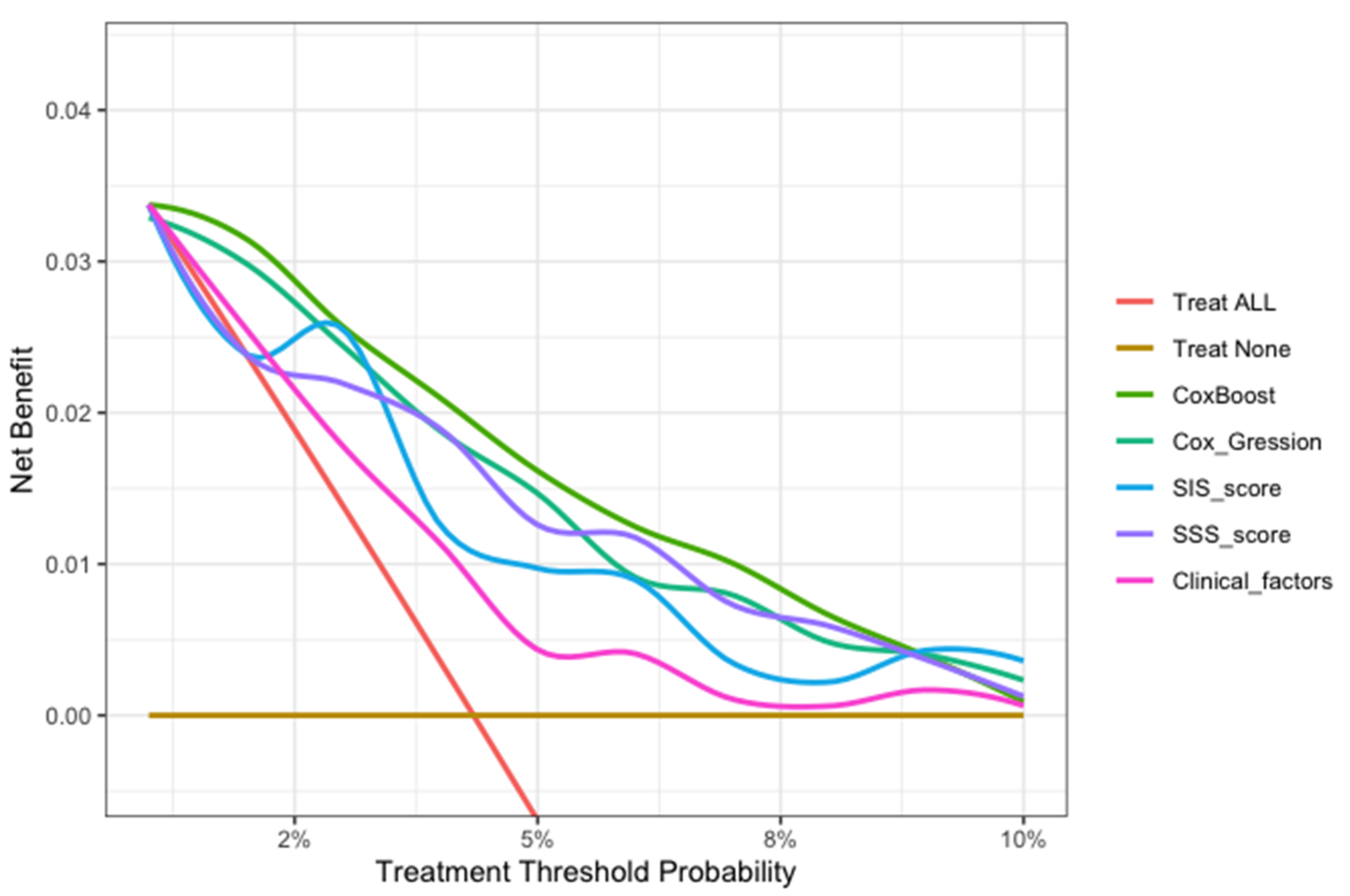Integrating Coronary Plaque Information from CCTA by ML Predicts MACE in Patients with Suspected CAD
Abstract
:1. Introduction
2. Materials and Methods
2.1. Study Population
2.2. Clinical Data
2.3. Image Acquisition and Analysis
2.4. Outcome
2.5. Machine Learning Algorithm with Survival Times
2.6. The Reference Models
2.7. Statistical Analysis
3. Results
3.1. Study Population
3.2. Feature Selection and Model Generation
3.3. Assessment of the Performance of Each Prediction Model
3.4. Model Evaluation Using Calibration and DCA
4. Discussion
4.1. Risk Stratification with CCTA
4.2. Machine Learning Algorithms Improve the Integration of Coronary Plaque Information for Survival Analysis
4.3. Study Limitations
5. Conclusions
Author Contributions
Funding
Institutional Review Board Statement
Informed Consent Statement
Data Availability Statement
Acknowledgments
Conflicts of Interest
References
- Danad, I.; Szymonifka, J.; Twisk, J.W.; Nørgaard, B.; Zarins, C.K.; Knaapen, P.; Min, J.K. Diagnostic performance of cardiac imaging methods to diagnose ischaemia-causing coronary artery disease when directly compared with fractional flow reserve as a reference standard: A meta-analysis. Eur. Heart J. 2016, 38, 991–998. [Google Scholar] [CrossRef] [PubMed]
- Moss, A.J.; Williams, M.C.; Newby, D.E.; Nicol, E.D. The Updated NICE Guidelines: Cardiac CT as the First-Line Test for Coronary Artery Disease. Curr. Cardiovasc. Imaging Rep. 2017, 10, 15. [Google Scholar] [CrossRef] [PubMed] [Green Version]
- Abdelrahman, K.M.; Chen, M.Y.; Dey, A.K.; Virmani, R.; Finn, A.V.; Khamis, R.Y.; Choi, A.D.; Min, J.K.; Williams, M.C.; Buckler, A.J.; et al. Coronary Computed Tomography Angiography From Clinical Uses to Emerging Technologies. J. Am. Coll. Cardiol. 2020, 76, 1226–1243. [Google Scholar] [CrossRef] [PubMed]
- Hoffmann, U.; Ferencik, M.; Udelson, J.E.; Picard, M.H.; Truong, Q.A.; Patel, M.R.; Huang, M.; Pencina, M.; Mark, D.B.; Heitner, J.F.; et al. Prognostic Value of Noninvasive Cardiovascular Testing in Patients With Stable Chest Pain: Insights From the PROMISE Trial (Prospective Multicenter Imaging Study for Evaluation of Chest Pain). Circulation 2017, 135, 2320–2332. [Google Scholar] [CrossRef]
- Schulman-Marcus, J.; ó Hartaigh, B.; Gransar, H.; Lin, F.; Valenti, V.; Cho, I.; Berman, D.; Callister, T.; DeLago, A.; Hadamitzky, M.; et al. Sex-Specific Associations Between Coronary Artery Plaque Extent and Risk of Major Adverse Cardiovascular Events: The CONFIRM Long-Term Registry. JACC Cardiovasc. Imaging 2016, 9, 364–372. [Google Scholar] [CrossRef] [Green Version]
- Williams, M.C.; Hunter, A.; Shah, A.S.V.; Assi, V.; Lewis, S.; Smith, J.; Berry, C.; Boon, N.A.; Clark, E.; Flather, M.; et al. Use of Coronary Computed Tomographic Angiography to Guide Management of Patients With Coronary Disease. J. Am. Coll. Cardiol. 2016, 67, 1759–1768. [Google Scholar] [CrossRef] [Green Version]
- Knuuti, J.; Wijns, W.; Saraste, A.; Capodanno, D.; Barbato, E.; Funck-Brentano, C.; Prescott, E.; Storey, R.F.; Deaton, C.; Cuisset, T.; et al. 2019 ESC Guidelines for the diagnosis and management of chronic coronary syndromes. Eur. Heart J. 2020, 41, 407–477. [Google Scholar] [CrossRef]
- Min, J.K.; Shaw, L.J.; Devereux, R.B.; Okin, P.M.; Weinsaft, J.W.; Russo, D.J.; Lippolis, N.J.; Berman, D.S.; Callister, T.Q. Prognostic Value of Multidetector Coronary Computed Tomographic Angiography for Prediction of All-Cause Mortality. J. Am. Coll. Cardiol. 2007, 50, 1161–1170. [Google Scholar] [CrossRef] [Green Version]
- Andreini, D.; Pontone, G.; Mushtaq, S.; Gransar, H.; Conte, E.; Bartorelli, A.L.; Pepi, M.; Opolski, M.P.; Hartaigh, B.Ó.; Berman, D.S.; et al. Long-term prognostic impact of CT-Leaman score in patients with non-obstructive CAD: Results from the COronary CT Angiography EvaluatioN For Clinical Outcomes InteRnational Multicenter (CONFIRM) study. Int. J. Cardiol. 2017, 231, 18–25. [Google Scholar] [CrossRef]
- Cury, R.C.; Abbara, S.; Achenbach, S.; Agatston, A.; Berman, D.S.; Budoff, M.J.; Dill, K.E.; Jacobs, J.E.; Maroules, C.D.; Rubin, G.D.; et al. CAD-RADSTM Coronary Artery Disease—Reporting and Data System. An expert consensus document of the Society of Cardiovascular Computed Tomography (SCCT), the American College of Radiology (ACR) and the North American Society for Cardiovascular Imaging (NASCI). Endorsed by the American College of Cardiology. J. Cardiovasc. Comput. Tomogr. 2016, 10, 269–281. [Google Scholar] [CrossRef] [Green Version]
- Bzdok, D.; Altman, N.; Krzywinski, M. Statistics versus machine learning. Nat. Methods 2018, 15, 233–234. [Google Scholar] [CrossRef] [PubMed]
- Van Rosendael, A.R.; Shaw, L.J.; Xie, J.X.; Dimitriu-Leen, A.C.; Smit, J.M.; Scholte, A.J.; van Werkhoven, J.M.; Callister, T.Q.; DeLago, A.; Berman, D.S.; et al. Superior Risk Stratification With Coronary Computed Tomography Angiography Using a Comprehensive Atherosclerotic Risk Score. JACC Cardiovasc. Imaging 2019, 12, 1987–1997. [Google Scholar] [CrossRef] [PubMed] [Green Version]
- Motwani, M.; Dey, D.; Berman, D.S.; Germano, G.; Achenbach, S.; Al-Mallah, M.H.; Andreini, D.; Budoff, M.J.; Cademartiri, F.; Callister, T.Q.; et al. Machine learning for prediction of all-cause mortality in patients with suspected coronary artery disease: A 5-year multicentre prospective registry analysis. Eur. Heart J. 2017, 38, 500–507. [Google Scholar] [CrossRef] [PubMed]
- Dey, D.; Gaur, S.; Ovrehus, K.A.; Slomka, P.J.; Betancur, J.; Goeller, M.; Hell, M.M.; Gransar, H.; Berman, D.S.; Achenbach, S.; et al. Integrated prediction of lesion-specific ischaemia from quantitative coronary CT angiography using machine learning: A multicentre study. Eur. Radiol. 2018, 28, 2655–2664. [Google Scholar] [CrossRef] [PubMed]
- Van Rosendael, A.R.; Maliakal, G.; Kolli, K.K.; Beecy, A.; Al’Aref, S.J.; Dwivedi, A.; Singh, G.; Panday, M.; Kumar, A.; Ma, X.; et al. Maximization of the usage of coronary CTA derived plaque information using a machine learning based algorithm to improve risk stratification; insights from the CONFIRM registry. J. Cardiovasc. Comput. Tomogr. 2018, 12, 204–209. [Google Scholar] [CrossRef]
- Abbara, S.; Arbab-Zadeh, A.; Callister, T.Q.; Desai, M.Y.; Mamuya, W.; Thomson, L.; Weigold, W.G. SCCT guidelines for performance of coronary computed tomographic angiography: A report of the Society of Cardiovascular Computed Tomography Guidelines Committee. J. Cardiovasc. Comput. Tomogr. 2009, 3, 190–204. [Google Scholar] [CrossRef]
- Kalaria, V.G.; Koradia, N.; Breall, J.A. Myocardial bridge: A clinical review. Catheter. Cardiovasc. Interv. 2002, 57, 552–556. [Google Scholar] [CrossRef]
- Small, G.R.; Chow, B.J.W. CT Imaging of the Vulnerable Plaque. Curr. Treat. Options Cardiovasc. Med. 2017, 19, 92. [Google Scholar] [CrossRef]
- Smits, P.C.; Pasterkamp, G.; Ufford, M.A.Q.V.; Eefting, F.D.; Stella, P.R.; De Jaegere, P.P.T.; Borst, C. Coronary artery disease: Arterial remodelling and clinical presentation. Heart 1999, 82, 461–464. [Google Scholar] [CrossRef] [Green Version]
- Maurovich-Horvat, P.; Ferencik, M.; Voros, S.; Merkely, B.; Hoffmann, U. Comprehensive plaque assessment by coronary CT angiography. Nat. Rev. Cardiol. 2014, 11, 390–402. [Google Scholar] [CrossRef]
- Tanaka, A.; Shimada, K.; Yoshida, K.; Jissyo, S.; Tanaka, H.; Sakamoto, M.; Matsuba, K.; Imanishi, T.; Akasaka, T.; Yoshikawa, J. Non-invasive assessment of plaque rupture by 64-slice multidetector computed tomography comparison with intravascular ultrasound. Circ. J. 2008, 72, 1276–1281. [Google Scholar] [CrossRef] [PubMed] [Green Version]
- Yin, P.; Dou, G.; Yang, X.; Wang, X.; Shan, D.; He, B.; Jing, J.; Jin, Q.; Chen, Y.; Yang, J. Noninvasive Quantitative Plaque Analysis Identifies Hemodynamically Significant Coronary Arteries Disease. J. Thorac. Imaging 2021, 36, 102–107. [Google Scholar] [CrossRef] [PubMed]
- Tibshirani, R. The lasso method for variable selection in the Cox model. Stat. Med. 1997, 16, 385–395. [Google Scholar] [CrossRef] [Green Version]
- Harald Binder. CoxBoost, Cox Models by Likelihood Based Boosting for a Single Survival Endpoint or Competing Risks. R Package Version 1.4. Available online: https://cran/R-project.org/package=CoxBoost.2013 (accessed on 2 March 2022).
- Binder, H.; Allignol, A.; Schumacher, M.; Beyersmann, J. Boosting for high-dimensional time-to-event data with competing risks. Bioinformatics 2009, 25, 890–896. [Google Scholar] [CrossRef] [PubMed] [Green Version]
- Binder, H.; Schumacher, M. Incorporating pathway information into boosting estimation of high-dimensional risk prediction models. BMC Bioinform. 2009, 10, 18. [Google Scholar] [CrossRef] [PubMed] [Green Version]
- Hadamitzky, M.; Achenbach, S.; Al-Mallah, M.; Berman, D.; Budoff, M.; Cademartiri, F.; Callister, T.; Chang, H.J.; Cheng, V.; Chinnaiyan, K.; et al. Optimized prognostic score for coronary computed tomographic angiography: Results from the CONFIRM registry (COronary CT Angiography EvaluatioN For Clinical Outcomes: An InteRnational Multicenter Registry). J. Am. Coll. Cardiol. 2013, 62, 468–476. [Google Scholar] [CrossRef] [Green Version]
- Binder, H.; Schumacher, M. Allowing for mandatory covariates in boosting estimation of sparse high-dimensional survival models. BMC Bioinform. 2008, 9, 14. [Google Scholar] [CrossRef] [Green Version]
- Tutz, G.; Binder, H. Boosting ridge regression. Comput. Stat. Data Anal. 2007, 51, 6044–6059. [Google Scholar] [CrossRef] [Green Version]
- Tutz, G.; Binder, H. Generalized Additive Modeling with Implicit Variable Selection by Likelihood-Based Boosting. Biometrics 2006, 62, 961–971. [Google Scholar] [CrossRef] [Green Version]
- Harrell, F.E.; Califf, R.M.; Pryor, D.B.; Lee, K.L.; Rosati, R.A. Evaluating the yield of medical tests. JAMA 1982, 247, 2543–2546. [Google Scholar] [CrossRef]
- Brier, G.W. Verification of forecasts expressed in terms of probability. Mon. Weather Rev. 1950, 78, 1–3. [Google Scholar] [CrossRef]
- Chow, B.J.; Small, G.; Yam, Y.; Chen, L.; Achenbach, S.; Al-Mallah, M.; Berman, D.S.; Budoff, M.J.; Cademartiri, F.; Callister, T.Q.; et al. Incremental prognostic value of cardiac computed tomography in coronary artery disease using CONFIRM: COroNary computed tomography angiography evaluation for clinical outcomes: An InteRnational Mul-ticenter registry. Circ. Cardiovasc. Imaging 2011, 4, 463–472. [Google Scholar] [CrossRef] [PubMed] [Green Version]
- Deseive, S.; Shaw, L.J.; Min, J.K.; Achenbach, S.; Andreini, D.; Al-Mallah, M.H.; Berman, D.S.; Budoff, M.J.; Callister, T.Q.; Cademartiri, F.; et al. Improved 5-year prediction of all-cause mortality by coronary CT angiography applying the CONFIRM score. Eur. Heart J. Cardiovasc. Imaging 2016, 18, 286–293. [Google Scholar] [CrossRef] [PubMed] [Green Version]
- Cheruvu, C.; Precious, B.; Naoum, C.; Blanke, P.; Ahmadi, A.; Soon, J.; Arepalli, C.; Gransar, H.; Achenbach, S.; Berman, D.S.; et al. Long term prognostic utility of coronary CT angiography in patients with no modifiable coronary artery disease risk factors: Results from the 5 year follow-up of the CONFIRM International Multicenter Registry. J. Cardiovasc. Comput. Tomogr. 2016, 10, 22–27. [Google Scholar] [CrossRef] [Green Version]
- Hadamitzky, M.; Täubert, S.; Deseive, S.; Byrne, R.A.; Martinoff, S.; Schömig, A.; Hausleiter, J. Prognostic value of coronary computed tomography angiography during 5 years of follow-up in patients with suspected coronary artery disease. Eur. Heart J. 2013, 34, 3277–3285. [Google Scholar] [CrossRef] [Green Version]
- Ahmadi, A.; Stone, G.W.; Leipsic, J.; Shaw, L.J.; Villines, T.C.; Kern, M.J.; Hecht, H.; Erlinge, D.; Ben-Yehuda, O.; Maehara, A.; et al. Prognostic Determinants of Coronary Atherosclerosis in Stable Ischemic Heart Disease: Anatomy, Physiology, or Morphology? Circ. Res. 2016, 119, 317–329. [Google Scholar] [CrossRef] [Green Version]
- Kolossváry, M.; Kellermayer, M.; Merkely, B.; Maurovich-Horvat, P. Cardiac Computed Tomography Radiomics: A Comprehensive Review on Radiomic Techniques. J. Thorac. Imaging 2018, 33, 26–34. [Google Scholar] [CrossRef] [Green Version]






| Features | Definition | Category |
|---|---|---|
| Demographic characteristics | ||
| Age | Age of the patient | continuous variable |
| BMI | Body mass index | continuous variable |
| Male | Are they male? | 1/0 = yes/no |
| Cardiovascular risk factors | ||
| Symptom | Types of chest pain | 0/1/2 = no/atypical/typical |
| Hyperlipemia | Is there hyperlipemia | 1/0 = yes/no |
| Hypertension | Is there hypertension | 1/0 = yes/no |
| Diabetes | Is there diabetes | 1/0 = yes/no |
| Currently smoking | Are they currently smoking | 1/0 = yes/no |
| Family history of CAD | Is there family history for CAD | 1/0 = yes/no |
| CCTA Features | ||
| Coronary dominance | Is there left/right/balanced dominance? | 1/2/3 = left/right/balanced |
| Myocardial bridge | Is there myocardial bridge? | 1/0 = yes/no |
| Vulnerable plaque | Are there two or more characteristics of vulnerable plaque? | 1/0 = yes/no |
| RCAp_composition | Composition of plaque in proximal RCA | 0/1/2/3 = normal/calcified/non-calcified/mix |
| RCAm_composition | Composition of plaque in middle RCA | 0/1/2/3 = normal/calcified/non-calcified/mix |
| RCAd_composition | Composition of plaque in distal RCA | 0/1/2/3 = normal/calcified/non-calcified/mix |
| P-PDA_composition | Composition of plaque in PDA of RCA origin | 0/1/2/3 = normal/calcified/non-calcified/mix |
| LM_composition | Composition of plaque in LM | 0/1/2/3 = normal/calcified/non-calcified/mix |
| LADp_composition | Composition of plaque in proximal LAD | 0/1/2/3 = normal/calcified/non-calcified/mix |
| LADm_composition | Composition of plaque in middle LAD | 0/1/2/3 = normal/calcified/non-calcified/mix |
| LADd_composition | Composition of plaque in distal LAD | 0/1/2/3 = normal/calcified/non-calcified/mix |
| D1_composition | Composition of plaque in D1 | 0/1/2/3 = normal/calcified/non-calcified/mix |
| D2_composition | Composition of plaque in D2 | 0/1/2/3 = normal/calcified/non-calcified/mix |
| LCXp_composition | Composition of plaque in proximal LCX | 0/1/2/3 = normal/calcified/non-calcified/mix |
| OM1_composition | Composition of plaque in OM1 | 0/1/2/3 = normal/calcified/non-calcified/mix |
| LCXd_composition | Composition of plaque in distal LCX | 0/1/2/3 = normal/calcified/non-calcified/mix |
| OM2_composition | Composition of plaque in OM2 | 0/1/2/3 = normal/calcified/non-calcified/mix |
| L-PDA_composition | Composition of plaque in PDA of LAD origin | 0/1/2/3 = normal/calcified/non-calcified/mix |
| R-PLB_composition | Composition of plaque in PLB of RCA origin | 0/1/2/3 = normal/calcified/non-calcified/mix |
| RI_composition | Composition of plaque in RI | 0/1/2/3 = normal/calcified/non-calcified/mix |
| L-PLB_composition | Composition of plaque in PLB of LAD origin | 0/1/2/3 = normal/calcified/non-calcified/mix |
| RCAp_length | Length of plaque in proximal RCA | 0/1/2/3 = normal/localized/segmental/diffuse |
| RCAm_length | Length of plaque in middle RCA | 0/1/2/3 = normal/localized/segmental/diffuse |
| RCAd_length | Length of plaque in distal RCA | 0/1/2/3 = normal/localized/segmental/diffuse |
| P-PDA_length | Length of plaque in PDA of RCA origin | 0/1/2/3 = normal/localized/segmental/diffuse |
| LM_length | Length of plaque in LM | 0/1/2/3 = normal/localized/segmental/diffuse |
| LADp_length | Length of plaque in proximal LAD | 0/1/2/3 = normal/localized/segmental/diffuse |
| LADm_length | Length of plaque in middle LAD | 0/1/2/3 = normal/localized/segmental/diffuse |
| LADd_length | Length of plaque in distal LAD | 0/1/2/3 = normal/localized/segmental/diffuse |
| D1_length | Length of plaque in D1 | 0/1/2/3 = normal/localized/segmental/diffuse |
| D2_length | Length of plaque in D2 | 0/1/2/3 = normal/localized/segmental/diffuse |
| LCXp_length | Length of plaque in proximal LCX | 0/1/2/3 = normal/localized/segmental/diffuse |
| OM1_length | Length of plaque in OM1 | 0/1/2/3 = normal/localized/segmental/diffuse |
| LCXd_length | Length of plaque in distal LCX | 0/1/2/3 = normal/localized/segmental/diffuse |
| OM2_length | Length of plaque in OM2 | 0/1/2/3 = normal/localized/segmental/diffuse |
| L-PDA_length | Length of plaque in PDA of LAD origin | 0/1/2/3 = normal/localized/segmental/diffuse |
| R-PLB_length | Length of plaque in PLB of RCA origin | 0/1/2/3 = normal/localized/segmental/diffuse |
| RI_length | Length of plaque in RI | 0/1/2/3 = normal/localized/segmental/diffuse |
| L-PLB_length | Length of plaque in PLB of LAD origin | 0/1/2/3 = normal/localized/segmental/diffuse |
| RCAp_stenosis | Stenosis of plaque in proximal RCA | 0/1/2/3/4 = normal/mininal/mild/moderate/severe |
| RCAm_stenosis | Stenosis of plaque in middle RCA | 0/1/2/3/4 = normal/mininal/mild/moderate/severe |
| RCAd_stenosis | Stenosis of plaque in distal RCA | 0/1/2/3/4 = normal/mininal/mild/moderate/severe |
| P-PDA_stenosis | Stenosis of plaque in PDA of RCA origin | 0/1/2/3/4 = normal/mininal/mild/moderate/severe |
| LM_stenosis | Stenosis of plaque in LM | 0/1/2/3/4 = normal/mininal/mild/moderate/severe |
| LADp_stenosis | Stenosis of plaque in proximal LAD | 0/1/2/3/4 = normal/mininal/mild/moderate/severe |
| LADm_stenosis | Stenosis of plaque in middle LAD | 0/1/2/3/4 = normal/mininal/mild/moderate/severe |
| LADd_stenosis | Stenosis of plaque in distal LAD | 0/1/2/3/4 = normal/mininal/mild/moderate/severe |
| D1_stenosis | Stenosis of plaque in D1 | 0/1/2/3/4 = normal/mininal/mild/moderate/severe |
| D2_stenosis | Stenosis of plaque in D2 | 0/1/2/3/4 = normal/mininal/mild/moderate/severe |
| LCXp_stenosis | Stenosis of plaque in proximal LCX | 0/1/2/3/4 = normal/mininal/mild/moderate/severe |
| OM1_stenosis | Stenosis of plaque in OM1 | 0/1/2/3/4 = normal/mininal/mild/moderate/severe |
| LCXd_stenosis | Stenosis of plaque in distal LCX | 0/1/2/3/4 = normal/mininal/mild/moderate/severe |
| OM2_stenosis | Stenosis of plaque in OM2 | 0/1/2/3/4 = normal/mininal/mild/moderate/severe |
| L-PDA_stenosis | Stenosis of plaque in PDA of LCX origin | 0/1/2/3/4 = normal/mininal/mild/moderate/severe |
| R-PLB_stenosis | Stenosis of plaque in PLB of RCA origin | 0/1/2/3/4 = normal/mininal/mild/moderate/severe |
| RI_stenosis | Stenosis of plaque in RI | 0/1/2/3/4 = normal/mininal/mild/moderate/severe |
| L-PLB_stenosis | Stenosis of plaque in PLB of LCX origin | 0/1/2/3/4 = normal/mininal/mild/moderate/severe |
| Characteristics | Total (n = 4017) | Training Dataset (n = 2812) | Testing Dataset (n = 1205) |
|---|---|---|---|
| Age (y) | 57.76 ± 10.98 | 57.43 ± 10.94 | 57.71 ± 10.86 |
| Male (n, %) | 2181 (54.29) | 1544 (54.91) | 637 (52.86) |
| BMI (kg/m2) | 25.47 ± 3.41 | 25.50 ± 3.43 | 25.40 ± 3.34 |
| SIS score | 1.80 ± 4.17 | 1.82 ± 2.05 | 1.74 ± 2.03 |
| Follow-up time (months) | 29.56 ± 5.94 | 29.51 ± 6.09 | 29.68 ± 5.57 |
| Chest symptom | |||
| No chest pain (n, %) | 1935 (48.17) | 1338 (47.58) | 597 (49.54) |
| Atypical chest pain (n, %) | 1692 (42.12) | 1192 (42.39) | 500 (41.49) |
| Typical chest pain (n, %) | 390 (9.71) | 282 (10.03) | 108 (8.96) |
| Cardiovascular risk factors | |||
| Hyperlipemia (n, %) | 1311 (32.64) | 912 (32.43) | 399 (33.11) |
| Hypertension (n, %) | 1916 (47.70) | 1333 (47.40) | 583 (48.38) |
| Diabetes (n, %) | 660 (16.43) | 451 (16.04) | 209 (17.34) |
| Currently smoking (n, %) | 1023 (25.47) | 716 (25.46) | 307 (25.48) |
| Family history of CAD (n, %) | 845 (21.04) | 593 (21.09) | 252 (20.91) |
| CCTA Finding | |||
| No CAD (n, %) | 1497 (37.27) | 1029 (36.6) | 468 (38.8) |
| Non-obstructive CAD (n, %) | 1328 (33.06) | 917 (32.6) | 411 (34.1) |
| Obstructive CAD (n, %) | 1192 (29.67) | 866 (30.8) | 326 (27.1) |
| Vulnerable plaque (n, %) | 35 (0.87) | 24 (0.85) | 11 (0.91) |
| Myocardial bridge (n, %) | 332 (8.26) | 221 (7.86) | 111 (9.21) |
| Coronary dominance | |||
| Left dominant (n, %) | 3736 (93.00) | 2613 (92.92) | 1123 (93.20) |
| Right dominant (n, %) | 198 (4.93) | 138 (4.91) | 60 (4.98) |
| Balanced type (n, %) | 83 (2.07) | 61 (2.17) | 22 (1.83) |
| Model | 6th Month C-Index | 12th Month C-Index | 18th Month C-Index | 24th Month C-Index | 30th Month C-Index |
|---|---|---|---|---|---|
| CoxBoost | 83.0 | 79.5 | 81.5 | 77.0 | 78.2 |
| Cox regression | 86.3 | 79.3 | 80.5 | 72.8 | 75.2 |
| SIS score | 80.0 | 71.5 | 73.3 | 71.8 | 74.2 |
| SIS score + clinical factors | 77.4 | 68.4 | 69.9 | 69.6 | 71.2 |
| Clinical factors | 67.6 | 67.4 | 67.0 | 63.9 | 65.3 |
| Model | AUC | 95%CI | p (CoxBoost vs.) |
|---|---|---|---|
| CoxBoost | 0.780 | 0.726, 0.834 | \ |
| Cox regression | 0.738 | 0.667, 0.809 | 0.048 |
| SIS score | 0.725 | 0.669, 0.782 | 0.010 |
| SIS score + clinical factors | 0.702 | 0.643, 0.762 | 0.003 |
| Clinical factors | 0.656 | 0.581, 0.730 | 0.005 |
| Model | 6th Month BS | 12th Month BS | 18th Month BS | 24th Month BS | 30th Month BS |
|---|---|---|---|---|---|
| CoxBoost | 0.004 | 0.006 | 0.020 | 0.033 | 0.039 |
| Cox regression | 0.004 | 0.012 | 0.021 | 0.033 | 0.039 |
| SIS score | 0.006 | 0.012 | 0.021 | 0.033 | 0.039 |
| SIS score + clinical factors | 0.004 | 0.011 | 0.020 | 0.033 | 0.039 |
| Clinical factors | 0.004 | 0.011 | 0.020 | 0.033 | 0.039 |
Publisher’s Note: MDPI stays neutral with regard to jurisdictional claims in published maps and institutional affiliations. |
© 2022 by the authors. Licensee MDPI, Basel, Switzerland. This article is an open access article distributed under the terms and conditions of the Creative Commons Attribution (CC BY) license (https://creativecommons.org/licenses/by/4.0/).
Share and Cite
Dou, G.; Shan, D.; Wang, K.; Wang, X.; Liu, Z.; Zhang, W.; Li, D.; He, B.; Jing, J.; Wang, S.; et al. Integrating Coronary Plaque Information from CCTA by ML Predicts MACE in Patients with Suspected CAD. J. Pers. Med. 2022, 12, 596. https://doi.org/10.3390/jpm12040596
Dou G, Shan D, Wang K, Wang X, Liu Z, Zhang W, Li D, He B, Jing J, Wang S, et al. Integrating Coronary Plaque Information from CCTA by ML Predicts MACE in Patients with Suspected CAD. Journal of Personalized Medicine. 2022; 12(4):596. https://doi.org/10.3390/jpm12040596
Chicago/Turabian StyleDou, Guanhua, Dongkai Shan, Kai Wang, Xi Wang, Zinuan Liu, Wei Zhang, Dandan Li, Bai He, Jing Jing, Sicong Wang, and et al. 2022. "Integrating Coronary Plaque Information from CCTA by ML Predicts MACE in Patients with Suspected CAD" Journal of Personalized Medicine 12, no. 4: 596. https://doi.org/10.3390/jpm12040596






